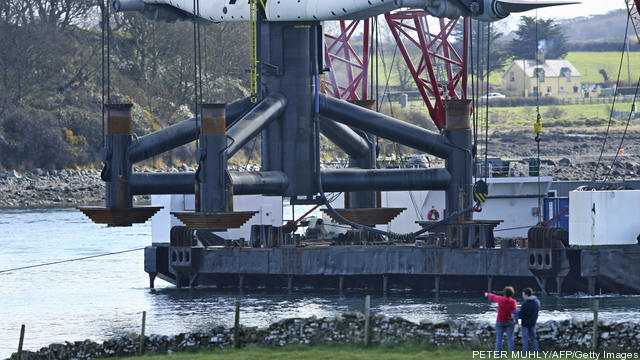
Tidal energy and telecoms are proving testy neighbors in the Pacific Northwest.
The Federal Energy Regulatory Commission (FERC) is trying to broker a peace between Snohomish Public Utility District, which wants to install the first tidal energy turbines on the West Coast, and PC Landing, which operates a major telecommunication cable between Washington State and Japan.
At issue is whether the two 150-kilowatt pilot turbines would be located so close to the cable at Puget Sound’s Admiralty Inlet that they’d endanger the cable.
Both technologies require room for periodic ship-borne maintenance and repair access, with subsurface equipment which could impinge on the other facility if they’re too close. And if one of the turbines breaks, as happened in 2010 with an earlier tidal turbine in the Bay of Fundy, PC Landing worries it could damage the nearby cable.
According to a FERC summary, the separation now proposed is 104 meters, or a bit more than a football field. Craig Collar, Snohomish senior manager for energy resource development, said the two turbines, which would be fixed to the seabed, would actually be between 170 and 240 meters distant.
PC Landing says working around the turbines would increase the cost and difficulty of cable repairs. The company would like to see a separation of 750-1,000 meters, said company CFO Kurt Johnson, but it is asking FERC to require at least 500 meters’ separation, citing an International Cable Protection Committee standard.
Technology Speeding Ahead of Regulation
The standard actually applies to separating two cables. There’s no standard yet for separation from tidal generators, since there are so few in the world and this is the first to come near a major transoceanic cable.
In neighboring Oregon, the state Ocean Energy Advisory Council has recommended an exclusion zone of 1,000 meters – a full kilometer – around marine cables.
The Federal Communications Commission and the Navy have chimed in at FERC, citing the importance of PC Landing’s cable to international telecommunications, including defense communications. They endorse a minimum 500-meter separation, but the FCC has recently said it could accept the 170-240 meters Snohomish is now discussing, if FERC builds in other safeguards for the cable.
The US Coast Guard has cautioned against moving the site too far west or south because of proximity to major shipping channels.
The FERC decision will have more than US ramifications: Snohomish’s turbine provider, OpenHydro, is Irish and PC Landing is headquartered in Japan.
In a technical conference in August, FERC officials asked Snohomish about potential alternate sites in Admiralty Inlet. According to a FERC summary of the meeting, Snohomish said no other site met its needs so well and cited delays involved in getting new studies and permits for any site change.
The turbines are to be in place just 3-5 years to gather data on tidal energy and a wide array of turbine environmental effects, after which they would be removed. Collar said Snohomish won’t make decisions about commercial deployment of more tidal turbines until it can study the results of this pilot.
Johnson said if there are no other sites suitable even for a pilot around Admiralty Inlet, there seems little reason to build there at all.
Snohomish officials argue they’ve been planning this since 2006, working with environmental agencies in Washington State and the Department of Energy’s Pacific Northwest National Laboratory (PNNL). The project has received $10 million in DOE funding, and the entire budget runs to $25 million. Snohomish PUD is the second-largest utility in Washington state, serving the region north of Seattle.
The opposition to the turbine site has arisen since Snohomish formalized the site selection in its permit application in March.
PC Landing’s Johnson said their cable has been operating for more than a decade and cost more than $1 billion to build. It’s clearly marked on marine charts and should have been avoided by Snohomish planners, he said.
Collar insisted the proposed separation is “more than sufficient.”
The next step appears to be a licensing decision from the FERC staff.
One other party, the Tulalip Tribes, is asking FERC to deny the permit altogether. The tribes say the turbines will infringe on tribal fishing rights, granted by treaty in 1855 and supported court decisions as recently as 1988. Though the area impinged is small, the tribes argue the turbines violate their treaty and would be illegal.
FERC has licensed two tidal projects in the US: one in Maine at Cobscook Bay and one in New York at Roosevelt Island on the East River.
